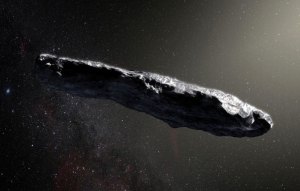
‘Oumuamua has been wandering between the stars for millions of years. Image: Original ESO/M. Kornmesser.
What’s 180 metres long, 30 metres wide, and travels between distant solar systems? No, it’s not a new NASA spacecraft. It’s a space rock known as ‘Oumuamua, and it’s the first known object from outside our solar system that has come to visit!
When ‘Oumuamua was first spotted last October, scientists knew there was something odd about. It was moving very fast, and going around the Sun in the opposite direction to Earth and the other planets. Scientists first guessed it was a comet, then an asteroid. Eventually, they decided it probably did not come from our solar system.
Plotting its course backwards, ‘Oumuamua came from a patch of space near the star Vega. When scientists did the calculations they realised it would have taken 600 000 years to get here, and 600 000 years ago, Vega was not in the same place.
Scientists are still searching for ‘Oumuamua’s source. Meanwhile, a group of astronomers has launched project Lyra – an ambitious scheme to visit the interstellar traveller. They want to launch a very fast spaceship to catch up to ‘Oumuamua and take measurements.
Project Lyra would tell us a lot about what we might find in other solar systems. But it will be tough to get a spaceship built and launched fast enough. The asteroid will pass Jupiter’s orbit in May this year, and by 2022 it will even pass the icy giant Neptune.
Sadly, it’s not coming back. ‘Oumuamua is going far too fast to orbit our Sun. Instead, it will float off into interstellar space. Maybe one day it will visit another solar system too!
If you’re after more science news for kids, subscribe to Double Helix magazine!

